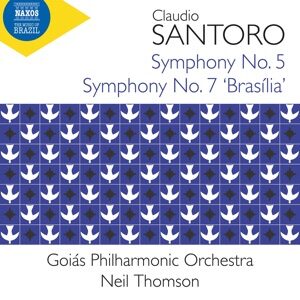Claudio Santoro (1919-89) composed fourteen symphonies over the course of about fifty years, making him one of the most noteworthy twentieth-century Brazilian composers in large forms. On evidence here, they are uneven in quality, with the problems occurring when you might expect–in the larger, more complex outer movements. I’m thinking especially of the Fifth Symphony, whose opening Andante mosso–Allegro moderato consists of a series of crescendos leading, essentially, nowhere. The thematic material isn’t too memorable either. The situation improves in the central scherzo and slow movement (a set of variations), but the same “sound and fury signifying nothing” returns in the finale. Santoro’s style incorporates obvious Brazilian elements without ever turning blatantly “folksy.” Clearly the idiom is his own.
This is even more evident in the Seventh Symphony, subtitled “Brasilia,” and designed for the dedication of the country’s new capital city. A more ambitious and successful work than the Fifth, this time with the scherzo played third rather than second, the music evolves from the relative harmonic simplicity of its opening to a more challenging language in the finale–from rural to urban, you might say. Whether this was Santoro’s intention I have no idea, but I like the result. There’s a good bit of stomping and pounding in this symphony–indeed in both works–with some enthusiastic use of the bass drum, but it all seems to be part and parcel of the music’s boldness and energy, and its confrontational gestural language never sounds merely gratuitous.
Certainly the Goiás Philharmonic under Neil Thomson has every reason to be proud of its achievement here. This is not easy music to play. Santoro’s writing for the violins, in particular, sounds positively wicked, with lots of passage-work at high speed, often reaching upwards into the nether regions of the instrument. The scherzos too offer plenty of rhythmic kinks to keep everyone alert, and the crispness of the orchestra’s response can only provoke admiration. There is another recording of Santoro symphonies on BIS which I reviewed previously, containing the avowedly socialist-realist No. 4 and the more intriguing No. 9. If you’re curious you may want to check that one out. In any case, this looks to be the first issue in a complete symphony edition, a project I look forward to hearing as it progresses.
































